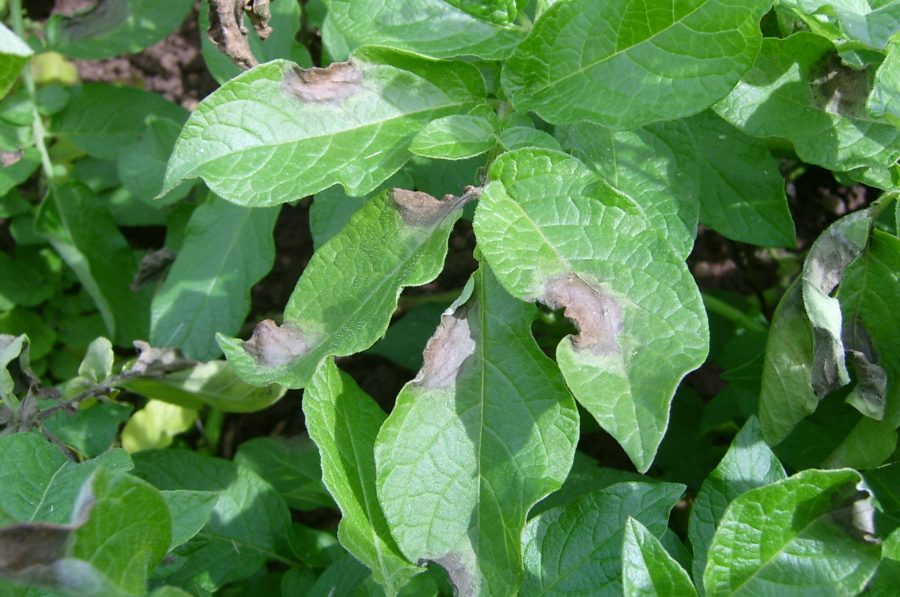Late blight pressure and a flurry of activity from blight scouts gives an early indication that new blight strain 37_A2 is on the rise. CPM reports.
By Lucy de la Pasture
For the first time, blight genotyping has been carried out in ‘real time’ this season by David Cooke at James Hutton Institute (JHI). The monitoring has been carried out following the spread of the blight strain 37_A2 (dark green) in the Netherlands (where it was first found in 2013), Germany, Belgium, and NW France where isolates of have shown a reduced sensitivity to fluazinam.
Over the summer, there’ve been 15 findings (up to 25 Sept) of the new blight strain, reported for the first time in the UK in 2016 in a very small number of samples.
“The results from this year’s genotyping work show the majority of samples have been from genotypes we would expect to see. Only 15 samples have tested positive as 37_A2, the remaining 107 are more common strains,” says AHDB’s Claire Hodge.
The small increase in EU_37 this season underlines the importance of not over-relying on an active ingredient, especially at the end of the season. This has been backed up in the independent Eurofins trials, where a surge in late blight pressure at the Derbys site has developed into one of the best tests of potato blight fungicides for many years.
Native blight strains
One trial, designed to mirror the Euroblight categorisation under UK conditions and in the presence of native blight strains, has underlined the importance of the rating, along with some interesting developments during 2017, reports Syngenta potato field technical manager, Douglas Dyas.
This year one trial protocol tested 13 different fungicides with single product used at weekly application right through the season. Infector rows between plots were inoculated with strains of blight and managed to induce high blight pressure across the site.
“Although in practice all growers and agronomists would select and alternate different blight products in a programme through the season, the trial is a genuine test of any fungicide active’s true capability, and how it performs under UK conditions with evolving blight strains,” explains Douglas.

Douglas Dyas says the Eurofins trials at the Derbys site has produced some interesting late-season findings.
He points out that this season has really pulled out some of the significant effects caused by different strains of the potato blight pathogen, and the challenges that creates for agronomists and growers.
“There have been increasing concerns over the continued effectiveness of fluazinam under the pressure of the specific blight strain, Dark Green 37_A2. Through the main part of the season the continued use of straight Shirlan (fluazinam) had looked extremely good until the end of Aug, when it collapsed completely – possibly indicating that Dark Green 37_A2 had come into the crop via natural infection.
Resistance strategy
“Fluazinam remains an extremely important tool for its zoospore activity to prevent tuber blight infection, so this trial has fully supported the advice intended to minimise the risk of the resistant strain building up. That includes always alternating applications with another active; mixing a partner product such as mancozeb and/or cymoxanil; maintaining robust rates and limiting the overall use of fluazinam,” he advises.
The independently assessed trial also indicates some other fluazinam mixtures, such as fluazinam plus dimethomorph and fluazinam plus cymoxanil, along with dimethomorph+ amectoctradin (Zampro), to be losing efficacy as the season progressed.
Douglas highlights another set of replicated trial plots, where Fubol Gold (mancozeb+ metalaxyl-M) had remained almost completely free of blight through to the end of the Aug assessments. Although the adjacent infector rows were inoculated with the Blue 13_A2 blight strain – which had historically shown resistance to phenylamide blight fungicides – the treatment had very effectively stopped foliar blight developing.
“The highly systemic nature of Fubol Gold does have some real value for use in the rapid canopy phase of crop growth. Agronomists visiting the trials indicated they see it may have a potential role at that timing, albeit for limited use and possibly in mixtures to counter the risk of Blue 13_A2 resistance issues,” he notes.
Mandipropamid top performer
The trials had also reinforced how mandipropamid products had remained at the top of the Euroblight table over many years, and continued to perform exceptionally well in the Eurofins UK equivalent.
“Revus was still the top performing straight active in the trials. At the end of Aug, when severity of blight infection had reached over 90% in untreated plots, the independently assessed Revus plots showed just 0.01% blight severity.
“Furthermore, although the trial was not looking at early blight (Alternaria), we included Amphore Plus (mandipropamid+ difenoconazole) in the protocol to assess its comparative performance on late blight. In actual fact, it proved even better – with no visible blight recorded in the end of Aug assessment,” says Douglas.
He believes this could be due to the formulation of the co-product mixture that had further enhanced the blight control, rather than the difenoconazole acting on the late blight strains.





